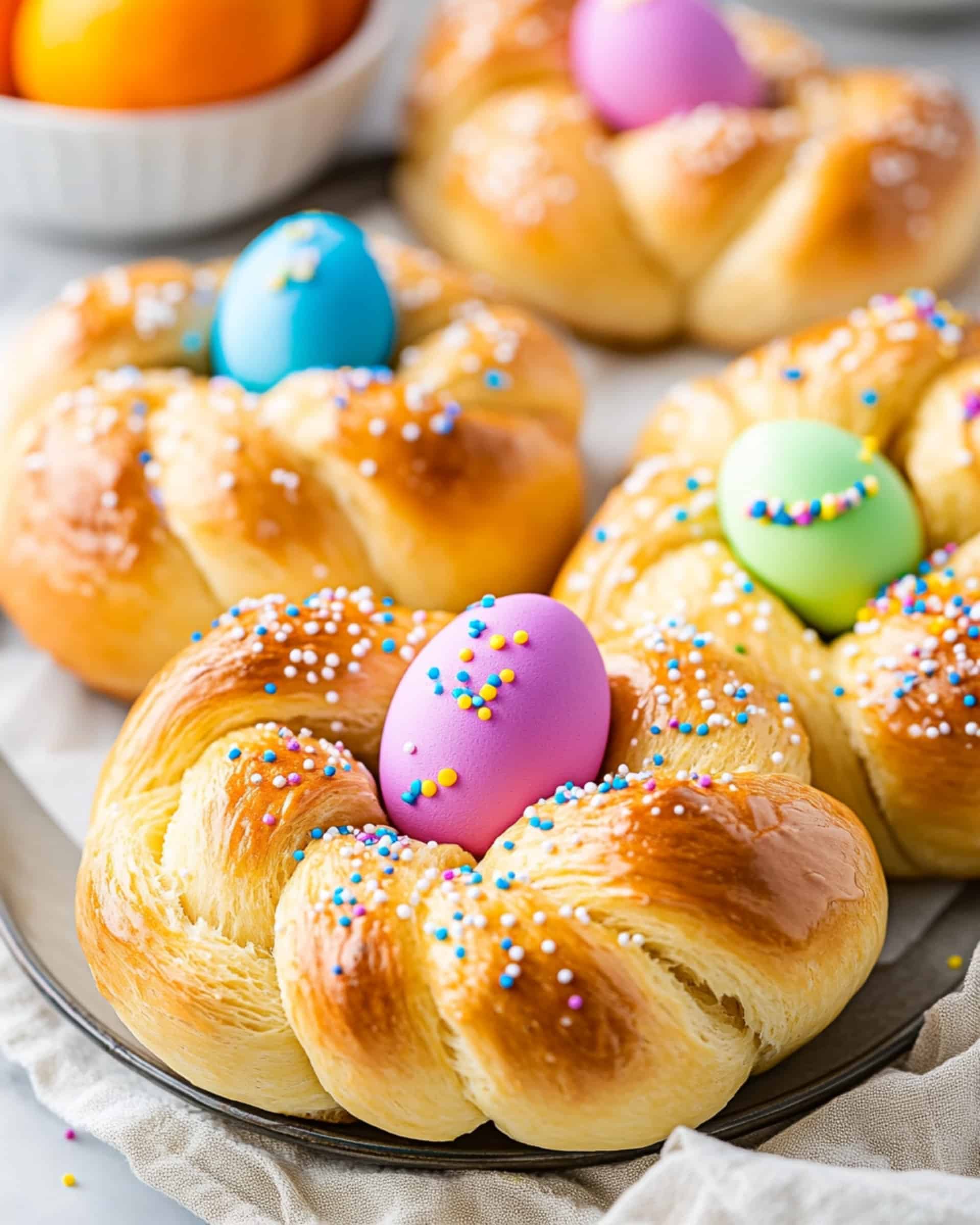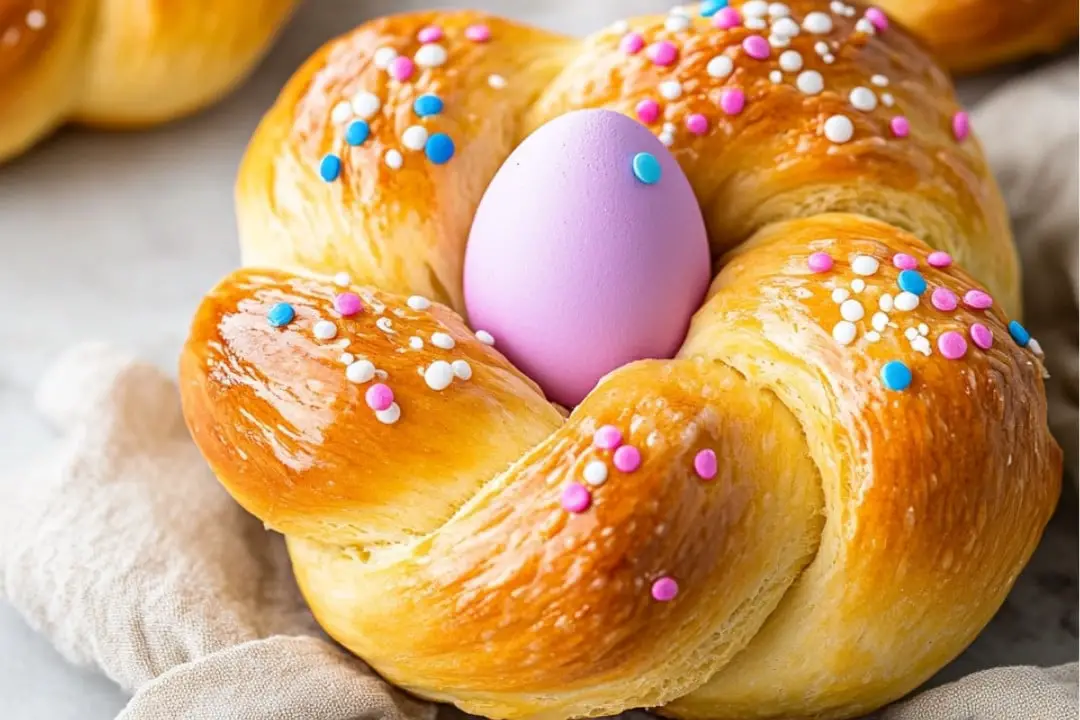This traditional Easter Bread is a showstopper that brings joy to any spring celebration. Soft, slightly sweet, and beautifully braided, this bread combines delicate citrus flavors with colorful decorations that make it truly special. The best part? It’s much easier to make than it looks, and your family will think you spent all day in the kitchen!
Why You’ll Love This Recipe
- Impressive presentation: The braided rings with colorful eggs create a stunning centerpiece that will have everyone reaching for their cameras before they reach for a slice.
- Wonderful texture: This bread has the perfect balance – tender and fluffy inside with a slightly crisp, golden exterior that’s simply irresistible.
- Citrus-infused flavor: The combination of orange and lemon zest gives this bread a bright, refreshing taste that perfectly complements the spring season.
- Fun family activity: Braiding the dough and decorating with colorful eggs makes this a perfect baking project to share with kids during the Easter season.
Ingredients You’ll Need
- Whole milk: Creates a rich, tender texture in the dough. The fat content matters here for achieving that perfect softness.
- Butter: Adds richness and flavor, making the bread deliciously tender. Don’t substitute with margarine if possible.
- All-purpose flour: Forms the structure of the bread. Make sure to measure it correctly – too much will make your bread dense.
- Granulated sugar: Provides just the right amount of sweetness and helps feed the yeast for a good rise.
- Rapid rise instant yeast: The magic ingredient that makes your bread rise. This type works faster than active dry yeast, saving you time.
- Lemon and orange zest: These bright flavors make this bread special, adding a subtle citrus note that’s unmistakably festive.
- Eggs: Add structure, richness, and color to the dough. They’re essential for that beautiful yellow crumb.
- Vanilla extract: Enhances the overall flavor profile with its warm, aromatic qualities.
- Uncooked dyed Easter eggs: The crowning glory! These colorful gems nestled in the bread create that iconic Easter look. They’ll soft-cook during baking.
- Sprinkles: Add a festive touch of color and sweetness that kids especially love.
Variations
Flavor Twists
- Cardamom Spice: Add 1 teaspoon of ground cardamom to the dough for a Scandinavian-inspired version.
- Almond Touch: Replace the vanilla extract with almond extract and add sliced almonds on top.
- Citrus Boost: Double the zest amounts for an extra-bright flavor profile.
Shape Alternatives
- Individual Rolls: Instead of rings, shape into small individual rolls with a single egg in each one.
- Braided Loaf: Create one large braided loaf for slicing instead of individual rings.
- Nest Shape: Form the dough into a nest shape and place multiple eggs in the center.
Decoration Options
- Sugar Glaze: Drizzle with a simple powdered sugar glaze after baking.
- Dried Fruit: Add dried cranberries or currants to the dough.
- Candied Citrus: Add chopped candied orange peel to the dough for extra citrus punch.
How to Make Easter Bread
Step 1: Prepare the Flour Mixture
In a large mixing bowl, combine 2 cups of flour with sugar, yeast, and both citrus zests. This dry mixture will become the foundation of your dough, and mixing these ingredients first helps distribute the flavors evenly.
Step 2: Warm the Milk and Butter
Place butter and milk in a microwave-safe container and warm until the butter is mostly melted. Be careful not to overheat – the mixture should feel warm to the touch, not hot. This perfect temperature activates the yeast without killing it.
Step 3: Create the Wet Mixture
Add eggs, vanilla, and the warm milk mixture to your dry ingredients. Mix with a dough hook for about a minute until it resembles cake batter. This stage creates the creamy base that will give your bread its tender crumb.
Step 4: Add Remaining Flour
Gradually add the remaining 2 cups of flour while continuing to mix. Keep going until the dough pulls away from the sides of the bowl, adding a bit more flour if needed. Knead with the dough hook for about 8 minutes until smooth and elastic.
Step 5: Rest the Dough
Form the dough into a ball and place it in a clean bowl. Cover with plastic wrap and let it rest for 15 minutes. This short rest allows the gluten to relax, making the dough easier to shape.
Step 6: Shape the Bread
Divide the dough into 8 equal pieces and roll each piece into an 11-inch rope. Take two ropes, pinch them together at one end, and braid them. Form each braid into a ring, pinching the ends to seal. This creates the nest-like shape that will cradle your Easter eggs.
Step 7: Let the Dough Rise
Place the braided rings on a parchment-lined baking sheet and cover with plastic wrap. Allow to rise in a warm place for 30 minutes to an hour, until the rings have doubled in size. This patience pays off in a lighter, fluffier texture.
Step 8: Add Finishing Touches
Brush the risen dough with egg wash (egg beaten with milk), then nestle an uncooked dyed Easter egg in the center of each ring. Sprinkle with colorful sprinkles for that festive touch.
Step 9: Bake to Golden Perfection
Bake at 375°F for 20 minutes, rotating the pan halfway through. The bread should be golden brown and sound hollow when tapped on the bottom. Let cool on a rack, but serve while still slightly warm for the best experience.
Pro Tips for Making the Recipe
- Get the milk temperature right: The milk mixture should be warm (about 110°F), not hot. Too hot will kill the yeast, too cool and it won’t activate properly.
- Don’t overwork the dough: Stop adding flour as soon as the dough comes together. Too much flour results in dry, dense bread.
- Create a warm rising environment: If your kitchen is cool, create a warm spot by preheating your oven for just a minute, then turning it off and placing the covered dough inside.
- Check for doneness: The bread should be golden brown and should sound hollow when tapped on the bottom. An instant-read thermometer inserted into the bread should read around 190°F.
- Watch the eggs: The eggs cook while the bread bakes, ending up similar to soft-boiled. If you want them to be fully hard-cooked, you can use pre-boiled dyed eggs instead.
How to Serve

Easter bread is versatile and can be enjoyed in several ways:
Breakfast or Brunch
Serve slices slightly warmed with butter and honey or jam alongside your Easter morning coffee or tea. It’s particularly wonderful with a citrus marmalade that echoes the zest in the dough.
Dessert
Transform it into a dessert by serving with a dollop of mascarpone or sweetened cream cheese. A drizzle of honey takes it to another level.
Easter Basket Addition
Include a small ring of Easter bread in each family member’s Easter basket as a special homemade treat among the chocolate eggs and jelly beans.
Gifting
Wrap a full ring in cellophane with a pretty ribbon to give as a thoughtful homemade gift to neighbors, teachers, or friends during the Easter season.
Make Ahead and Storage
Preparing Ahead
You can prepare the dough the day before and let it rise slowly in the refrigerator overnight. Bring to room temperature before shaping into rings.
Storing Leftovers
Store completely cooled bread in an airtight container at room temperature for up to 3 days. If you’ve included the eggs, remove them and store them separately in the refrigerator.
Freezing
The bread freezes beautifully without the eggs. Wrap tightly in plastic wrap and then foil, and freeze for up to 3 months. Thaw at room temperature before serving.
Reheating
To restore that fresh-baked taste, warm individual slices or whole rings in a 300°F oven for 5-10 minutes. This revives the texture and brings out the citrus aromas again.
FAQs
Do I have to use the colored eggs? Will they be safe to eat?
The eggs cook during baking to about soft-boiled consistency. If you’re concerned, you can use hardboiled dyed eggs instead (they may become a bit overcooked but will be safe), or simply remove them before eating the bread. The eggs are largely decorative, though they can certainly be eaten if properly handled.
Can I make this bread without a stand mixer?
Absolutely! While a stand mixer makes the process easier, you can mix the dough with a wooden spoon until it becomes too difficult, then turn it out onto a floured surface and knead by hand for about 10-12 minutes until smooth and elastic.
My dough isn’t rising well. What went wrong?
Check that your yeast is fresh and hasn’t expired. Also, make sure your milk mixture wasn’t too hot (which kills yeast) or too cold (which doesn’t activate it). The ideal temperature is around 110°F, or warm to the touch but not hot. Finally, yeast loves a warm environment – if your kitchen is cold, find a warmer spot for rising.
Can I make this bread less sweet?
Yes, you can reduce the sugar to as little as 2 tablespoons if you prefer a less sweet bread. The texture may be slightly different, but it will still be delicious with the citrus flavors shining through even more.
Final Thoughts
This Easter Bread isn’t just a recipe—it’s a tradition that creates memories. The beautiful braided rings with their colorful eggs celebrate the season of renewal in the most delightful way. Don’t be intimidated by the braiding process; it’s simpler than it looks, and even imperfect braids bake up beautifully. Whether you’re continuing a family tradition or starting a new one, this bread brings a special touch to your Easter table that store-bought treats simply can’t match. The subtle citrus flavor, tender texture, and festive appearance make this worth the little bit of extra effort. Give it a try this Easter—your family will thank you!
Print
Easter Bread Recipe
- Prep Time: 1 hour
- Cook Time: 45 minutes
- Total Time: 2 hours 5 minutes
- Yield: 4 pieces 1x
- Category: Bread
- Method: Baking
- Cuisine: Easter
- Diet: Vegetarian
Description
A delightful and festive Easter Bread recipe, perfect for the holiday season. This soft and slightly sweet bread is braided, adorned with colorful sprinkles, and features nestled dyed eggs. A wonderful centerpiece for any Easter celebration.
Ingredients
For the Dough
-
-
- 1 cup whole milk
- 1/4 cup butter
- 4 cups all-purpose flour, divided (2 cups and 2 cups)
- 1/3 cup granulated sugar
- 2 1/4 teaspoons rapid rise instant yeast (1 package)
- Zest of 1 lemon
- Zest of 1 orange
- 2 eggs
- 1 teaspoon vanilla extract
-
For the Egg Wash
-
-
- 1 egg
- 1 teaspoon milk
-
For Decorations
-
- Dyed Easter eggs (uncooked – NOT hardboiled)
- Colorful sprinkles
Instructions
- Mix Dry Ingredients: In a large mixing bowl, combine two cups of flour with the sugar, yeast, lemon zest, orange zest, and salt (if using). Mix together with a spoon and set aside.
- Prepare Milk and Butter Mixture: Place butter and milk in a microwave-safe bowl or measuring cup. Warm the mixture in the microwave, heating for 1 minute, then stirring. Continue heating in 10-second intervals until the mixture is warm but not boiling.
- Combine Wet and Dry Ingredients: Add the eggs, vanilla extract, and warmed milk mixture to the bowl with the dry ingredients. Using the dough hook of a stand mixer, mix the ingredients for about 1 minute until the consistency resembles cake batter.
- Add Remaining Flour: Gradually add the remaining 2 cups of flour to the mixer while continuing to knead with the dough hook, until the dough becomes smooth. If it sticks to the bowl, add a tablespoon of flour and continue mixing. Knead for about 8 minutes.
- Knead Dough by Hand: Place the dough on a lightly floured surface or silpat mat and knead by hand a few times to form a smooth ball. Use as little flour as necessary to prevent sticking.
- Rest the Dough: Transfer the dough to a clean bowl, cover with plastic wrap, and let it rest for 15 minutes.
- Shape the Dough: Punch down the dough to release air, then divide into 8 equal pieces. Roll each piece into ropes about 11 inches long. Pinch two ropes together at the top and braid them. Form the braid into a ring and pinch the ends together.
- Proof the Rings: Place the braided rings on a parchment-lined baking sheet, cover with plastic wrap, and let rise in a warm place for 30-60 minutes, or until doubled in size.
- Prepare the Oven: Preheat the oven to 375℉ while the dough is rising.
- Make the Egg Wash: In a small bowl, combine 1 egg and 1 teaspoon of milk. Beat together with a fork to create an egg wash.
- Decorate the Dough: After the dough has risen, use a pastry brush to apply the egg wash to the surface of each ring. Nestle a dyed Easter egg in the center of each ring and sprinkle with colorful sprinkles.
- Bake the Bread: Bake the rings for 20 minutes, rotating the baking sheet halfway through to ensure even cooking. Once done, let the bread cool on a cooling rack. Serve warm and enjoy your festive Easter Bread!
Notes
- Storage: Once fully cooled, store at room temperature in an airtight container for 3 days, or in the fridge for 5 days. Remove the eggs if storing at room temperature and keep them in the fridge.
- Freezing: The bread can be stored in a zip-top bag in the freezer for up to 3 months. Ensure the eggs are removed before freezing.
- Serving Suggestion: Easter Bread is best served warm!
Nutrition
- Serving Size: 1 piece




Your email address will not be published. Required fields are marked *